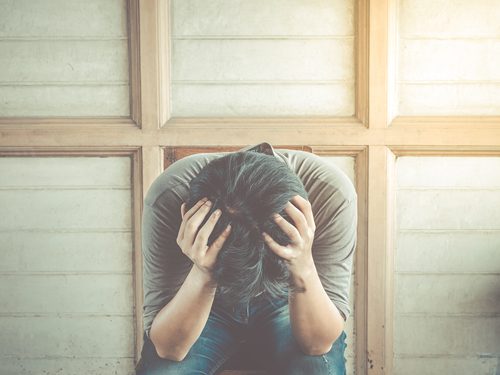 Breaking the Cycle of Addiction
Breaking the Cycle of Addiction
Americans suffer from anxiety disorders at an increasing rate.
According to the Anxiety and Depression Association of America, 18% of Americans over the age of 18 suffer from anxiety, and only 36% seek treatment for it. Anxiety co-occurs with addiction at higher than-average rates. People with an anxiety disorder are two to three times more likely to have an alcohol or substance use disorder than the general population. Anxiety leads to substance use and is caused by it.
What Does An Anxiety Disorder Feel Like?
Everyone suffers from anxiety from time to time. Anxiety becomes a disorder when it interferes with your work, relationships, and quality of life. The five main types of anxiety disorders are generalized anxiety disorder (GAD), social anxiety disorder, post-traumatic stress disorder (PTSD), obsessive-compulsive disorder (OCD), and panic disorder.
While each of these disorders has its unique set of symptoms, some general symptoms of anxiety are feelings of fear and dread, irritability, feeling tense, and feeling blank. You can read more about anxiety at this site, which includes a short quiz to help you determine if you suffer from an anxiety disorder
You can also read personal accounts like this one from Isabella Mitchell’s blog post on The Mighty:
“I have generalized anxiety disorder (GAD), an illness that makes me feel anxious and worried about everyday things or seemingly nothing at all. I know my worries are often unrealistic, but that doesn’t make them easier to deal with. I often feel like I’m not in control of my emotions, and when my anxiety is bad it affects every part of my life. I have trouble sleeping, eating, working, maintaining relationships, concentrating, and breathing.”
Substance-Induced Anxiety Disorder
It’s easy to understand why an anxiety disorder would lead to substance use disorder: people want to feel better. They want relief from the pain and fear. What’s more complex is the process by which a person without an anxiety disorder can develop one as a result of substance use disorder: what doctors call substance-induced anxiety disorder.
Substance-induced anxiety disorder can feel confusing for the user, as they tend to associate drugs or alcohol with feeling more relaxed. There are two types of substance-induced anxiety, one which begins during intoxication and lasts as long as the person keeps using, and one that begins with withdrawal and lasts a few hours to a few weeks.
People looking to relieve anxiety often turn to the “self-medication trio”: alcohol, benzodiazepines (e.g., Valium, Xanax, Klonopin, Ativan, Restoril), and/or nicotine. These substances all work similarly, flooding the brain’s reward center with dopamine, calming the nerve activity and creating a feeling of relaxation and drowsiness. When used together, these substances have a cumulative effect, potentially deadening the brain’s nerve activity to a point of distress.
These substances can create more anxiety in the user because, over time, the brain develops tolerance and requires more of the substance to have the same effect. In other words, users will feel anxious more easily and turn to substances more quickly to relieve their anxiety.
Benzos create a particular climate for anxiety during and after withdrawal. Because long-term use of benzos increases the number of the brain’s dopamine receptors, users become even more sensitive to anxiety-evoking situations and thus require greater levels of the drug to calm their nerves. They enter a cycle of self-medication and rebound anxiety.
Treatment for Anxiety and Addiction
When someone has a dual-diagnosis (also called a co-occurring disorder) of anxiety and addiction, special treatment is required. Ideally, the person goes through a period of medically-supervised detoxification, ridding the body of the substances at a pace that will cause the least discomfort, while concurrently working with a therapist to learn how to manage the anxiety.
Cognitive Behavioral Therapy (CBT) is often used with clients who suffer from anxiety. CBT helps clients identify patterns of behavior that lead to anxiety and replace them with new patterns. The therapy focuses on how our thoughts influence our emotions, and how we can alleviate anxiety by changing the way we think.
Because those with anxiety are much more likely to relapse after treatment, it’s important that they receive quality inpatient treatment from a facility like Mountain Laurel Recovery Center that specializes in working with dual-diagnosis clients. Extended aftercare is also crucial to continually reaffirm the new patterns the client is working to establish.
If you are currently trying to handle your anxiety through self-medication with alcohol or drugs, consider changing course. If you believe you are suffering from addiction as well as anxiety, contact a treatment center like Mountain Laurel Recovery Center to get a free assessment and individualized treatment plan.
Alternative Treatments for Anxiety
If you are not yet addicted but are afraid of what will happen if you stop self-medicating, consider alternative treatments to anxiety disorders. In addition to professional therapy/counseling, acupuncture, meditation, yoga, diet, and some herbal remedies or whole food supplements might provide great relief. Talk to your doctor or health care professional about these options.
Sources:
psychologytoday.com/blog/where-addiction-meets-your-brain/201408/anxiety-and-addiction

 Breaking the Cycle of Addiction
Breaking the Cycle of Addiction